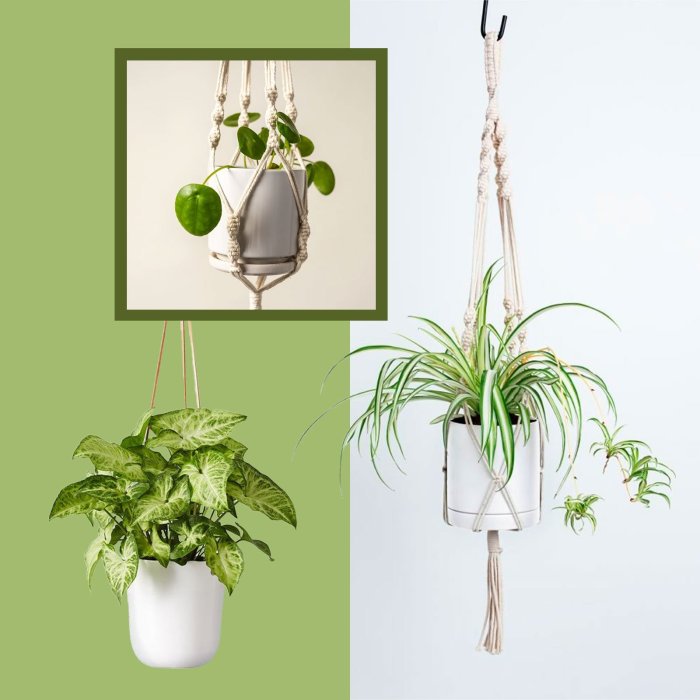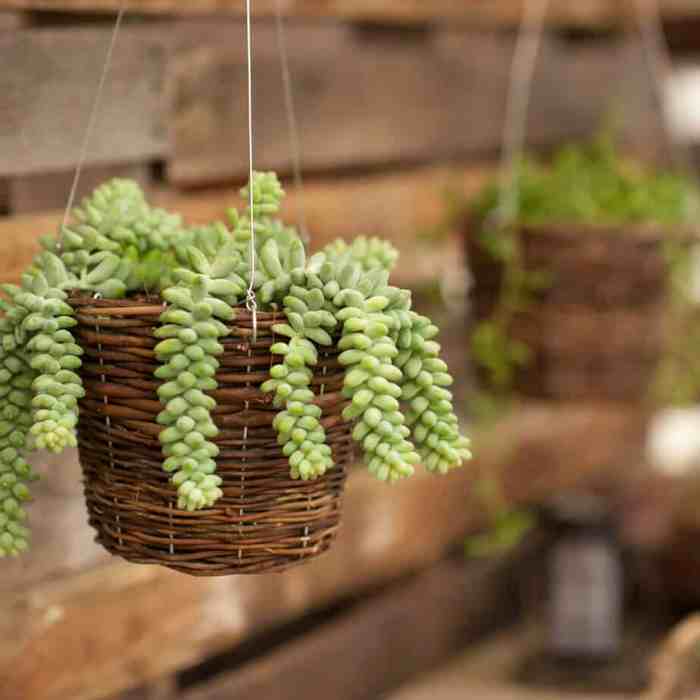With live indoor hanging plants taking center stage, this article invites you to explore the captivating world of greenery and its transformative power. From purifying the air we breathe to reducing stress and enhancing our well-being, live indoor hanging plants offer a wealth of benefits that will elevate your home or indoor space.
Delve into the diverse world of live indoor hanging plants, discover their unique characteristics, and learn how to care for them with ease. Embrace the creative display ideas to showcase these botanical wonders in your home and troubleshoot any challenges that may arise.
Join us as we uncover the secrets to thriving live indoor hanging plants and unlock the beauty and benefits they bring.
Types of Live Indoor Hanging Plants
Incorporating live indoor hanging plants into your home décor adds a touch of nature, purifies the air, and creates a sense of tranquility. These plants come in various types, each with unique characteristics that can complement any space.
Popular Live Indoor Hanging Plants
Some of the most popular live indoor hanging plants include:
- Spider Plant (Chlorophytum comosum): Known for its long, arching leaves with white or variegated stripes, this easy-to-care-for plant purifies the air and produces plantlets (baby spiders) that can be propagated.
- Pothos (Epipremnum aureum): With its heart-shaped leaves that come in various shades of green, yellow, and white, pothos is a versatile plant that can tolerate low light conditions.
- String of Pearls (Senecio rowleyanus): This unique succulent features trailing stems adorned with tiny, spherical leaves that resemble strings of pearls.
- Burro’s Tail (Sedum morganianum): Another succulent, burro’s tail has plump, fleshy leaves that cascade downwards, creating a dramatic effect.
- Peperomia (Peperomia spp.): Peperomia comes in a wide variety of species, each with distinctive foliage shapes and colors, making it a great choice for adding diversity to hanging planters.
- Hoya (Hoya spp.): Hoyas are known for their waxy, fragrant flowers that bloom in clusters. They prefer bright, indirect light and can tolerate some neglect.
- Ferns (Pteridophyta): Ferns add a touch of elegance to any space with their delicate fronds. They prefer humid environments and can tolerate low light conditions.
- Air Plants (Tillandsia spp.): Air plants are unique in that they don’t require soil and absorb nutrients from the air. They come in a variety of shapes and sizes, making them a versatile choice for hanging arrangements.
Benefits of Live Indoor Hanging Plants
Incorporating live indoor hanging plants into a home or indoor space offers numerous benefits, ranging from improved air quality to reduced stress levels. Scientific studies have demonstrated the positive impact of these plants on overall well-being.
Air Quality Improvement, Live indoor hanging plants
- Hanging plants absorb pollutants and toxins from the air, such as benzene, formaldehyde, and trichloroethylene.
- A study by NASA found that certain plants, including spider plants and peace lilies, can effectively remove up to 90% of volatile organic compounds (VOCs) from the air within 24 hours.
Stress Reduction
- The presence of plants has been shown to reduce stress and anxiety levels.
- A study published in the journal “Environmental Health Perspectives” found that people who viewed plants for 15 minutes experienced a significant reduction in stress hormone levels.
Enhanced Well-being
- Hanging plants create a more inviting and relaxing atmosphere.
- Studies have shown that plants can improve mood, boost creativity, and enhance overall cognitive function.
- Additionally, the act of caring for plants can provide a sense of purpose and fulfillment.
Care and Maintenance of Live Indoor Hanging Plants

Ensuring the well-being of live indoor hanging plants requires attentive care and maintenance practices. By adhering to specific guidelines, plant owners can nurture healthy, thriving greenery that enhances their living spaces.
Live indoor hanging plants add a touch of nature to any room. To display these plants effectively, consider using a hanging plant rod indoor . These rods provide a sturdy and stylish way to suspend your plants from the ceiling, allowing them to cascade down and create a lush, verdant display.
Essential care requirements for hanging plants encompass watering, lighting, and fertilization. Watering frequency depends on the plant species and the environment, typically ranging from once a week to every few days. Adequate lighting is crucial, with bright, indirect light being optimal for most hanging plants.
Fertilization should be done every few months, using a balanced fertilizer diluted to half strength.
Watering Techniques
Proper watering techniques are paramount for maintaining the health of hanging plants. Overwatering can lead to root rot, while underwatering can cause wilting and stunted growth. To determine the ideal watering frequency, consider the plant’s species, pot size, and environmental conditions.
In general, it is advisable to water when the top inch of soil feels dry to the touch.
For those looking to bring life into their indoor spaces, live indoor hanging plants offer a vibrant and elegant solution. Among the most popular choices are best indoor trailing plants , which cascade gracefully from their pots, adding a touch of greenery and movement to any room.
From the delicate tendrils of the String of Pearls to the lush foliage of the Pothos, live indoor hanging plants are a versatile and stylish way to enhance the ambiance of any home.
Lighting Requirements
Hanging plants have diverse lighting needs, depending on their species. Some, such as ferns and pothos, thrive in low to medium light conditions, while others, like succulents and cacti, prefer bright, direct light. To ensure optimal growth, it is essential to research the specific lighting requirements of each plant and provide an appropriate location.
Fertilization Tips
Regular fertilization is crucial for providing hanging plants with essential nutrients. A balanced fertilizer, diluted to half strength, should be applied every few months during the growing season. Avoid over-fertilizing, as this can lead to nutrient burn and damage to the plant.
Creative Display Ideas for Live Indoor Hanging Plants

Transform your home into a lush oasis by showcasing live indoor hanging plants in captivating and stylish ways. Explore innovative mounting options and unique display techniques to elevate your interior décor.
Macrame Hangers
Embrace the bohemian charm of macrame hangers, meticulously crafted from intricate knots. Suspend trailing plants, such as ferns or pothos, from these elegant hangings, adding a touch of natural beauty to any corner of your home.
Ceiling Hooks
Maximize vertical space by utilizing ceiling hooks. Install sturdy hooks at varying heights to create a cascading effect with trailing plants like ivy or philodendron. The lush foliage will create a dramatic and eye-catching display.
Wall-Mounted Planters
Incorporate greenery into your walls with wall-mounted planters. Choose planters with geometric designs or earthy textures to complement your home’s aesthetic. Plant succulents, air plants, or trailing vines to add a touch of living art to your walls.
Troubleshooting Common Issues with Live Indoor Hanging Plants
Maintaining the health and beauty of live indoor hanging plants requires regular care and attention. However, various issues can arise during their growth, including yellowing leaves, pests, and stunted growth. Identifying and addressing these problems promptly is crucial for preserving the vitality of the plants.
Yellowing Leaves
Yellowing leaves can indicate several underlying issues:
- Overwatering:Excess waterlogging can suffocate the roots, leading to yellowing and wilting leaves. Check the soil moisture regularly and allow it to dry out slightly between waterings.
- Underwatering:Insufficient watering can also cause leaves to turn yellow and drop. Water the plants thoroughly when the soil feels dry to the touch.
- Nutrient deficiency:Yellowing leaves can also be a sign of nutrient deficiency, particularly nitrogen. Fertilize the plants regularly with a balanced fertilizer.
- Sunlight deficiency:Hanging plants require adequate sunlight for photosynthesis. Move the plants to a brighter location or provide supplemental lighting.
Pests
Common pests that can affect hanging plants include aphids, mealybugs, and spider mites. These pests can cause damage to leaves and stems, leading to stunted growth and yellowing. Regular inspection of the plants and prompt treatment with insecticidal soap or neem oil can help control infestations.
Stunted Growth
Stunted growth can be caused by various factors:
- Rootbound:As plants grow, their roots need more space to expand. If the roots become rootbound, it can restrict growth and nutrient absorption. Repot the plants into larger containers with fresh potting mix.
- Lack of nutrients:Regular fertilization is essential for providing plants with the nutrients they need for healthy growth. Fertilize the plants every few weeks with a balanced fertilizer.
- Overcrowding:Hanging multiple plants too close together can limit their access to sunlight and nutrients, leading to stunted growth. Space the plants adequately to allow for proper airflow and growth.
Concluding Remarks: Live Indoor Hanging Plants

Live indoor hanging plants are not just decorative elements; they are living wonders that enhance our lives in countless ways. By incorporating these botanical companions into our homes, we not only create visually stunning spaces but also foster a healthier and more vibrant environment.
Embrace the joy of live indoor hanging plants, and let their beauty and benefits transform your space into a sanctuary of well-being and style.
Detailed FAQs
What are the most popular types of live indoor hanging plants?
Some of the most popular types include pothos, spider plants, philodendrons, ferns, and succulents.
How often should I water my live indoor hanging plants?
Watering frequency depends on the type of plant, but a general rule is to water when the soil feels dry to the touch.
What are some creative ways to display live indoor hanging plants?
You can use macrame hangers, ceiling hooks, wall-mounted planters, or even repurposed items like baskets or jars.